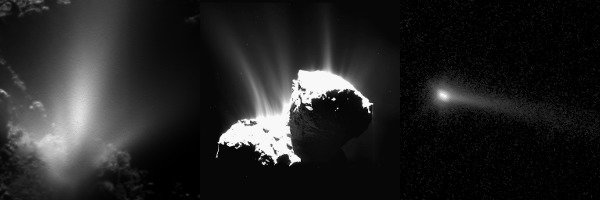
Activity of Comets and Asteroids
The group focusses on understanding the activity of comets and asteroids. The small bodies of the solar system, including comets and asteroids, are remnants of planet formation. However, in the 4.5 billion years since their formation, these bodies have been subject to various processes that influenced their structure and composition, such that it is not immediately clear how their current state reflects their primordial properties. The emission of dust and gas (=activity) from a comet or asteroid is a by-product of contemporary erosion processes. Studying activity leads us to better understand how comets and asteroids evolve with time, and what the properties of their surfaces and sub-surface layers are. We follow a multi-disciplinary approach to characterise activity and the eroded material, analysing data from the European Space Agency's Rosetta mission to comet 67P/Churyumov-Gerasimenko and from ground- and space-based telescopes, and connecting them through numerical modelling.
Cometary activity

Rosetta data have shown that activity in comet 67P is influenced by factors such as local topography, nucleus shape, orbit, and spin, and that many different processes contribute to the activity even in this single comet. The activity has both a regular component recurring during each comet rotation and an irregular component reflected in outbursts, and is modulated by seasons. While it is very likely that activity is ultimately fuelled by solar energy input, the detailed working of the processes leading to the lifting and acceleration of dust and debris is less clear. We study activity from the combined perspective of multiple Rosetta instruments, to constrain the properties of the ejected material and the surface changes associated with different types of activity. Understanding how solar irradiation affects the upper layers of a comet, how energy is stored and ultimately released again will provide insight into the structure and composition of the cometary material.
Asteroid activity

While comets have spent most of the time since their formation in the cold outer solar system beyond Neptune, asteroids have been orbiting the Sun in the warmer region between the orbits of Mars and Jupiter for a considerable time, and are therefore significantly depleted in volatiles.
In recent years, dust activity has been discovered in ~20 asteroids. These objects are further divided into at least two sub-groups, one likely characterised by sublimation-driven activity, and the other activated by instantaneous processes like impact or rotational breakup. We observe active asteroids with ground-based telescopes and the Hubble Space Telescope, and infer the nature of the emission processes from the motion of the ejected material under the influence of solar gravity and radiation pressure. The dust motion bears information on the initial velocity and sizes of the ejected grains and on the time and duration of the activity. We also measure the rotation periods of active asteroids. The goal is to evaluate the relative importance of processes involved in asteroid activity, in particular that of rapid rotation.
Ice in comets and asteroids

It is currently not well understood on which spatial scales refractory material (“dust”) and ice are mixed in a comet or asteroid, and what their mixing ratio is. However, these are key pieces of information on the process of planetesimal- and ultimately planet formation. We constrain the dust-to-ice ratio in 67P from observations and thermal modelling of large, possibly icy chunks ejected from specific sites on the comet. Characterising the present and past water content of comets and asteroids is highly relevant also for understanding the origin of water on Earth, since both populations are suspected to have implanted significant quantities of water onto our planet during a turbulent phase of the solar system, the Late Heavy Bombardment (LHB) 4-3.9 billion years ago.
Physical properties of dust

From most comets and active asteroids, we can only observe scattered sunlight and thermal infrared radiation. In order to interpret such observations, it is necessary to relate the optical and thermal properties of cometary and asteroidal material to parameters that are less directly accessible, such as the size distribution, density, structure, and composition. These quantities are, however, constrained by data from the instruments on board Rosetta and from samples returned to Earth by the Stardust and Hayabusa missions. We use these data to model the light scattering and thermal emission, aiming at a comprehensive characterisation of comet dust within the observational constraints.
Comet 67P in context

Spacecraft can only explore a small number of solar system bodies, while for the vast majority we have to rely on telescopic observations. We explore the link between the processes observed in detail in the close vicinity of comet 67P and its appearance to an Earth-based observer, using models of the dust dynamics. We evaluate to which degree factors specific to this single comet (e.g. seasons, nucleus shape, outbursts) influence the remote appearance of its dust tail, and infer the possibilities and limits of ground-based observations alone to characterise a comet.
















